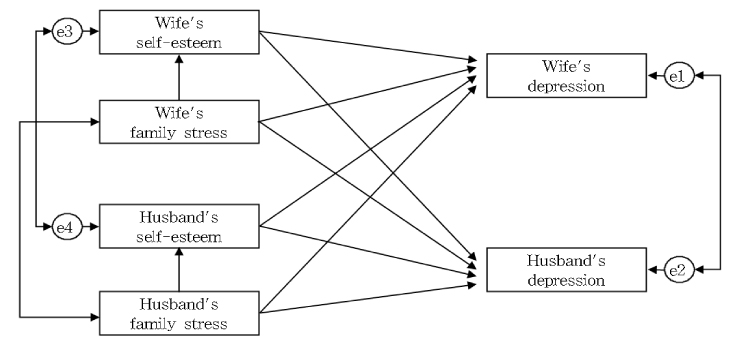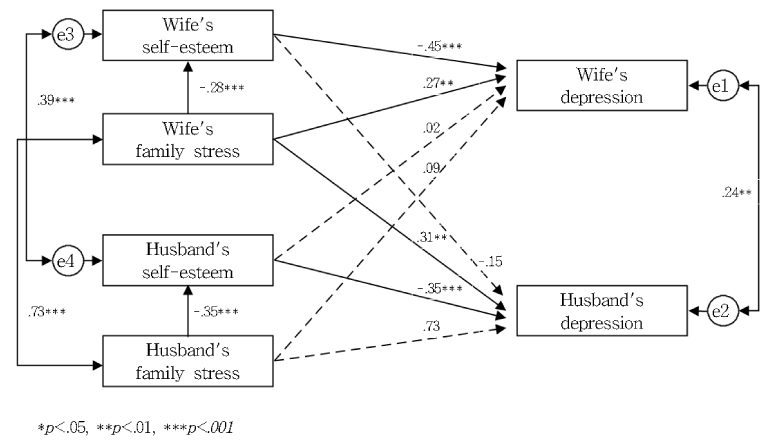J Korean Acad Psychiatr Ment Health Nurs.
2014 Jun;23(2):60-69.
The Effects of Self-esteem and Family Stress on Depression of Middle-aged Couples: Analysis of Actor-Partner Interdependence Model
- Affiliations
-
- 1College of Nursing Science, East-west Research Institute, Kyung Hee University, Korea. sunghshin@khu.ac.kr
Abstract
- PURPOSE
This study was done to examine actor and partner effect of self-esteem and family stress on depression of middle-aged married couples.
METHODS
Participants were 133 couples aged 40-60 years, who lived in Seoul, Incheon, or Gyeonggi provinces. All measures were self-administered. Data were analyzed using SPSS 18.0 and AMOS 18.0 program.
RESULTS
Husband and wife's self-esteem had an actor effect (wife beta=-.45, p<.001; husband beta=-.35, p<.001 respectively) on their depression. Wife's family stress had an actor effect (beta=.27, p=.006) on her depression and a partner effect (beta=.31, p=.002) on her husband's depression. Meanwhile, it also had an indirect effect on her depression through self-esteem (beta=-.28, p<.001). Husband's family stress did not have an actor effect or a partner effect on his depression, but it had an indirect effect on his depression through self-esteem (beta=-.35, p<.001).
CONCLUSION
Results indicate that to prevent the constantly increasing depression of middle-aged married couples, programs should be conducted for both of the couple, but focused differently for wife and husband.
Keyword
Figure
Reference
-
1. 2012 Social indicators in Korea. Statistics Korea;2013.2. Kim SY, Lee JI. A study on aging anxiety, depression, and self-esteem of middle-aged people. J Korean Acad Fundam Nurs. 2007; 14(1):103–109.3. Khandelwal S, Chowdhury A, Regmi SK, Mendis N, Kittirattanapaiboon P. Conquering depression: you can get out of the blues. New Delhi: WHO Regional Office for South-East Asia;2001.4. Kang IH. Increasing depression and bipolar disorder in elderly patients, seniors mental health red light. The Kyunghyang Shinmun. 2013. 10. 02.5. Park GJ, Lee JH, Kim MO, Bang BK, Youn SJ, Choi EJ. Relationships among perceived life stress, self-esteem and depression in middle-aged women. J Korean Community Nurs. 2002; 13(2):354–362.6. Lee KE, Choi US. The depression in middle-aged women in Gangwondo. J Korean Acad Womens Health Nurs. 1999; 5(3):299–312.7. Kim ML, Song KY. Changes of the level of physical self-efficacy, depression and stress of middle-aged men according to the stage of exercise change. J Korea Contents Assoc. 2009; 9(9):393–402.
Article8. Lee SS, Choi WH. The relationship between depression and stress in Korean middle-aged women. J Korean Soc Matern Child Health. 2007; 11(2):185–196.
Article9. Kim MR. The relationship between married womens' life stress and depression tendency: the mediating and moderating effects of self-esteem. Korean J Health Psychol. 2007; 12(4):761–777.
Article10. Choi MR, Lee IH. The moderating and mediating effects of self-esteem on the relationship between stress and depression. Korean J Clin Psychol. 2003; 22(2):363–383.11. Lee SM, Kim GS. The effect of family stress and family strengths on depression of married people. J Fam Relat. 2012; 17(3):3–22.12. Kim JH, Choi HC. Self-esteem as a mediator between instrumentality, gender role conflict and depression in korean middle-aged men. Korean J Health Psychol. 2007; 12(2):145–160.13. Kenny DA. Models of non-indepependence in dyadic research. J Soc Pers Relat. 1996; 13(2):279–294. http://dx.doi.org/10.1177/0265407596132007.14. Cook WL, Kenny DA. The actor-partner interdependence model: a model of bidirectional effects in developmental studies. Int J Behav Dev. 2005; 29(2):101–109. http://dx.doi.org/10.1080/01650250444000405.
Article15. Townsend AL, Baila M, Shenyang G. Depressive symptomatology in middle-aged and older married couples: a dyadic analysis. J Gerontol B Psychol Sci Soc Sci. 2001; 56(6):S352–S364. http://dx.doi.org/10.1093/geronb/56.6.s352.
Article16. Cook WL, Snyder DK. Analyzing nonindependent outcomes in couple therapy using the actor-partner interdependence model. J Fam Psychol. 2005; 19(1):133–141. http://dx.doi.org/10.1037/0893-3200.19.1.133.
Article17. Kang HS, Kim YH. Actor and partner effect of couple's personality on marital satisfaction. Korean J Couns. 2012; 13(6):2861–2880.
Article18. Yun EK, Shin SH. The actor effect and the partner effect of self-esteem and mother-adolescent communication on depression in mothers and adolescents in Kirogi families according to adolescent' development stage. J Korean Acad Nurs. 2010; 40(5):620–630.
Article19. Ko SJ, Shin SH. Effects of dementia knowledge, self-efficacy and depression on dementia preventive behavior in elderly couples: dyadic data analysis. J Korean Acad Nurs. 2013; 43(2):276–286. http://dx.doi.org/10.4040/jkan.2013.43.2.276.
Article20. Erikson EH. Childhood and society. 2nd ed. New York: Norton;1963.21. Faul F, Erdfelder E, Lang AG, Buchner A. G*Power 3: a flexible statistical power analysis program for the social, behavioral, and biomedical sciences. Behav Res Methods. 2007; 39(2):175–191. http://dx.doi.org/10.3758/bf03193146.
Article22. Radloff L. The CES-D Scale: a self report depression scale for research in the general population. Appl Psychol Meas. 1977; 1(3):385–401. http://dx.doi.org/10.1177/014662167700100306.23. Cho MJ, Kim KH. Diagnostic validity of the CES-D (Korean version) in the assessment of DSM-III-R major depression. J Korean Neuropsychiatr Assoc. 1993; 32(3):381–399.24. Rosenberg M. Society and adolescents self-image. Princeton: Princeton University Press;1965.25. Jeon BJ. Self-esteem: a test of its measurability. Yonsei Nonchong. 1974; 11(1):109–129.26. McCubbin HI, Patterson J, Wilson L. Family inventory of life events and changes (FILE). St. Paul, Minnesota: Family Social Science, University of Minnesota;1979.27. Kim TH, Kang I. A study on the mid-life family stress and family coping strategies. J Korean Home Econ Assoc. 1990; 28(4):103–117.28. Hong SH. The criteria for selecting appropriate fit indices in structural equation modeling and their rationales. Korean J Clin Psychol. 2000; 19(1):161–177.29. Park E. A study on social support and depression by gender among adults. Korean J Women Health Nurs. 2011; 17(2):169–177. http://dx.doi.org/10.4069/kjwhn.2011.17.2.169.
Article30. Shin KR. Depression among Korean women. J Korean Acad Nurs. 2001; 31(3):391–400.
Article
- Full Text Links
- Actions
-
Cited
- CITED
-
- Close
- Share
- Similar articles
-
- The Effects of Climacteric Symptom Cognition, Self-efficacy on Aging Anxiety in Middle-Aged Couples: Actor and Partner Interdependence Mediation Model
- Actor and Partner Effects of Health Status, Marital Satisfaction and Self Efficacy on Retirement Preparation of Middle Aged Couples: Actor-Partner Interdependence Model Analysis
- Mediating effect of Maternal and Paternal Family Relationship between Neuroticism and Postpartum Depression: The Actor-Partner Interdependence Mediation Model
- Health Promoting Behavior in Pregnant Couples: Actor-Partner Interdependence Model Analysis
- Impact of Sexual Attitude and Marital Intimacy on Sexual Satisfaction in Pregnant Couples: An Application of the Actor-Partner Interdependence Model



